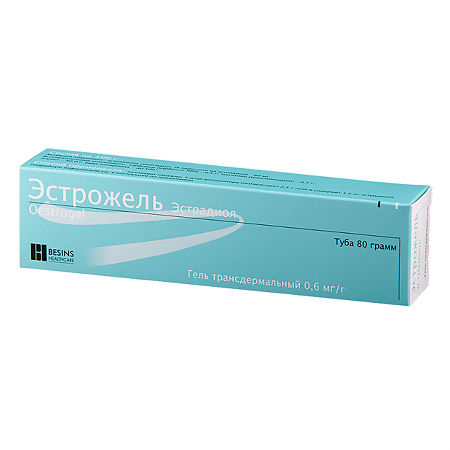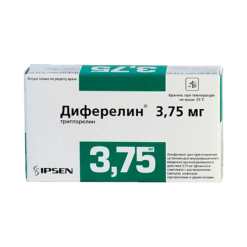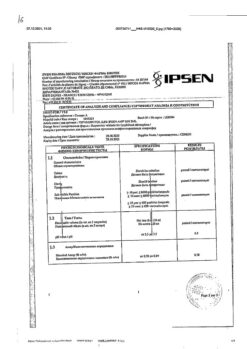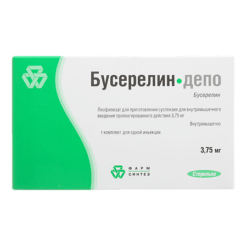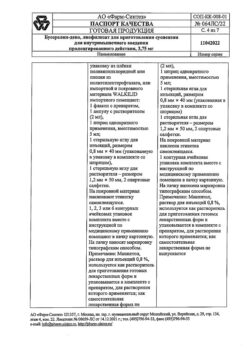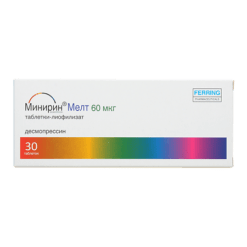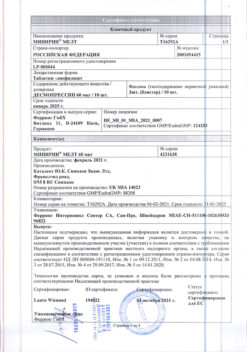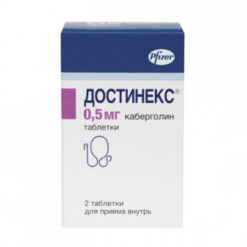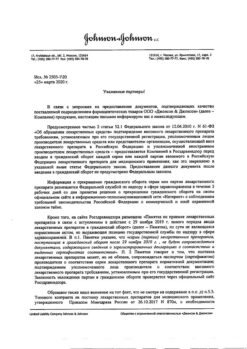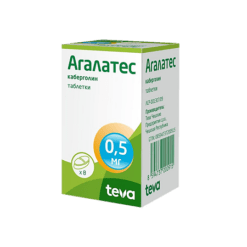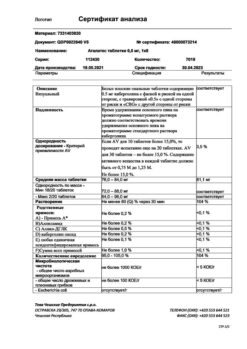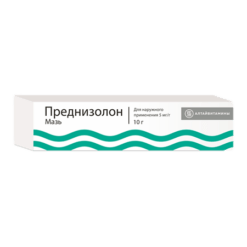No products in the cart.
Estrogel, transdermal gel 600 mcg/g 80 g
€1.00
Out of stock
(E-mail when Stock is available)
Description
Pharmacotherapeutic group
Estrogen
Description
Colorless transparent gel with an odor of ethanol.
ATX code: G03CA03
Pharmacological action
Pharmacodynamics
The active ingredient of Estrogel® is 17β-estradiol chemically and biologically identical to endogenous human estradiol.
It has estrogenic effect on the main target organs: ovaries, endometrium, vaginal epithelium, mammary glands, urethra, hypothalamus, pituitary gland, liver – similar to the effect of endogenous estrogens in the follicular phase of menstrual cycle.
Maintains estrogen deficiency in women during menopause and reduces the severity of menopausal disorders including hot flashes, excessive sweating at night, atrophic changes in the urinary tract (atrophic vulvovaginitis, dyspareunia, urinary incontinence) and psycho-emotional disorders.
The clinical effectiveness of Estrogel® in the treatment of menopausal symptoms is comparable to that of oral estrogens.
Estradiol lowers total cholesterol without changing the cholesterol/HDL ratio.
It has a procoagulant effect, increases the synthesis in the liver of vitamin K-dependent clotting factors (II, VII, IX, X), reduces the concentration of antithrombin III.
Estradiol prevents loss of bone mass associated with natural menopause or ovariectomy.
Estrogen deficiency in postmenopause is associated with decreased bone mineral density (BMD). The effect of estrogen on BMDM is dose-dependent and appears to continue for as long as hormone replacement therapy (HRT) is in place. After discontinuation of HRT, BMSCs begin to decline at the same rate as they did before HRT began.
The data from the randomized, placebo-controlled Women’s Health Initiative (WHI) study and a meta-analysis of clinical trials showed that MHT with estrogen alone or estrogen in combination with gestagens in healthy postmenopausal women reduces the risk of hip, spine, and other osteoporotic fractures. There is also limited evidence that MHT can prevent bone fractures in women with low BMD and/or established osteoporosis.
Pharmacokinetics
Absorption and distribution
When the gel is applied topically over a large skin surface, the alcohol evaporates and approximately 10% of estradiol is absorbed through the skin into the vascular system, regardless of the patient’s age.
Daily application of 2,5 g or 5 g of Estrogel® on an area of 400-750 cm2 leads to gradual increase of concentration of estradiol and estrone and provides their equilibrium concentration in blood plasma in about 3-5 days in the ratio typical for the beginning of the middle follicular phase of menstrual cycle. At application of Estrogel® in 17 postmenopausal women once daily by application on the back surface of one arm from wrist to shoulder during 14 days the maximum concentration (Cmax) of estradiol and estrone in plasma was 117 pg/ml and 128 pg/ml, respectively. The mean plasma concentrations of estradiol and estrone over a 24-hour time interval after administration of 2.5 g of Estrogel® on day 12 of administration were 76.8 pg/ml and 95.7 pg/ml, respectively.
Metabolism and excretion
Estradiol is metabolized mainly in the liver to estriol, estrone and their conjugated metabolites (glucuronides, sulfates). These metabolites undergo intrahepatic recirculation. After discontinuation of treatment, estradiol concentrations return to baseline after approximately 76 h.
Indications
Indications
Active ingredient
Active ingredient
Composition
Composition
Composition per 1 g gel:
Active substance:
Estradiol hemihydrate 0.6 mg
[in terms of estradiol]
Associates:
Carbomer (carbopol 980) 5.0 mg,
trolamine (triethanolamine) 5.0 mg,
ethanol 400 mg,
purified water qs. to 1 g.
How to take, the dosage
How to take, the dosage
EstroGel® is administered externally, continuously or in cycles.
The dose and duration of therapy are individualized.
In general, the starting dose of the drug is 2.5 g of gel once a day, which corresponds to 1.5 mg of estradiol. In most patients, this dose is effective for relieving menopausal symptoms. If after one month of therapy the efficacy is not achieved, it is possible to increase the daily dose of the drug to a maximum of 5 g of gel, which corresponds to 3.0 mg of estradiol.
To initiate and continue therapy for menopausal symptoms, the minimum effective dose should be used for the minimum period of time.
Prevention of osteoporosis in postmenopausal women
The minimum effective dose in the majority of patients is 2.5 g of EstroGel® once daily.
When using the tube formulation, the plastic dosing applicator is used to measure the daily dose:
1 dose of the applicator is 2.5 g of gel (which corresponds to 1.5 mg of estradiol).
If the product is used in the “bottle” formulation, 1.25 g of gel (corresponding to 0.75 mg of estradiol) is released with a single press of the dispenser pump, which is equal to half of the daily dose. The average daily dose of the drug is 2.5 g of gel (2 pressings on the pump dispenser).
Performance of the drug in tube form: open the tube and pierce the metal membrane of the tube with the small puncher on top of the tube lid. The desired dose is extracted from the tube using the ruler of the applicator.
1 dose corresponds to a column of extracted gel with a diameter corresponding to the diameter of the tube outlet, the length of which coincides with the recess on the applicator ruler. The recess has a line that allows dividing the daily dose in half. One tube of gel will hold 30 doses.
To use the product in its bottle form, remove the cap from the bottle and press down firmly on the dispenser pump with your other hand to collect the gel. The dose that is released when you first press it may not be accurate. It is recommended to discard it. The bottle is designed for 64 squeezes. After 64 squeezes, the amount of gel released by one squeeze may be less than you need. Because of this, do not use the bottle after 64 pushes on the pump.
The use of EstroGel® without the addition of gestagen is only possible in patients who have had their uterus removed.
Patients with an intact (not removed) uterus should be given gestagen during treatment with Estrogel®.
In the menopausal transition, treatment should be given for at least 3 consecutive weeks, followed by a break of 1 week, while gestagen is given orally for the last 12 to 14 days of the month.
In perimenopause, treatment can be given from day 1 to day 25 of the month at the same time as oral gestagen. During the one-week break, menstrual-like bleeding may occur due to a decrease in sex hormones. It is recommended to use only those gestagens that are approved for use at the same time as estrogens.
In postmenopause, treatment with estrogens in combination with gestagens is a continuous regimen.
Long-term estrogen monotherapy is indicated in women after hysterectomy. In women who have had a hysterectomy, the addition of gestagens in the absence of a history of endometriosis is not recommended.
Depending on clinical symptomatology, dose adjustments are made after 2-3 cycles of treatment, as follows:
– If symptoms of hyperestrogenia appear, such as feeling of tension in the mammary glands, feeling of fullness in the abdomen and pelvis, feeling of anxiety, nervousness, aggressiveness, dose reduction is necessary;
If symptoms of hypoestrogenia, such as persistent hot flashes, dry vaginal mucosa, headache, sleep disturbances, asthenia, and a tendency to be depressed, the dose should be increased.
In women who have not used OST medicines before and in women changing over to Estrogel® from combined OST medicines with a continuous regimen, treatment with Estrogel® can be started on any day convenient for a patient. In women switching to EstroGel® from a continuous sequential regimen of ZGT, treatment should be started after completion of the previous regimen.
If a patient forgets to apply the gel, this should be done as soon as possible, but no later than 12 hours after application. If more than 12 hours have elapsed, application of Estrogel® should be postponed until the next time. Irregular application of the drug (missed doses) may cause “breakthrough” bleeding and “smeary” bloody discharge.
How to use
Patients apply the gel by themselves in a thin layer to clean, dry skin on the abdomen, lumbar area, shoulders or forearms until completely absorbed. The area of application should be at least the area of 2 palms.
Do not massage the area where the gel is applied. Avoid contact of the gel with the mammary glands and the mucosa of the vulva and the vagina.
Application is considered correct and effective if the gel is absorbed completely within 2-3 minutes.
If the sticky consistency persists for more than 5 minutes after application, then too little skin surface has been covered.
You should wash your hands immediately after applying the gel.
Interaction
Interaction
The use of Estrogel® together with surfactants (e.g., sodium lauryl sulfate) or other substances that change the structure or barrier function of the skin may reduce its effectiveness. Therefore, avoid co-application of the product with strong detergents and detergents (e.g., those containing benzalkonium or benzethonium chloride), skin care products with high alcohol content (astringents, sunscreens) and keratolytic agents (e.g., salicylic or lactic acid).
The use of any concomitant medications that have a damaging effect on the skin (e.g., cytotoxic) should be avoided.
The metabolism of estradiol is accelerated with concomitant use with inducers of microsomal liver enzymes, such as antiepileptic drugs (phenobarbital, phenytoin, carbamazepine); some antibiotics and antiviral drugs (rifampicin, rifabutin, nevirapine, efavirenz); herbal medicines containing St. John’s wort.
Ritonavir and nelfinavir, also known as strong inhibitors, in contrast show inducing properties when used together with sex hormones.
Transdermal use avoids the effect of “primary” passage through the liver, so that the effect of MHT drugs with transdermal estrogen application may be less dependent on the action of microsomal liver enzyme inducers than with oral use.
The metabolism of estradiol is accelerated with concomitant use with tranquilizers (anxiolytics), narcotic analgesics, anesthetics.
The concentration of estradiol in plasma also decreases with concomitant use with some antibiotics (penicillins and tetracyclines).
The action of estradiol is enhanced with folic acid and thyroid hormone drugs.
In clinical practice, increased estrogen metabolism can lead to a weakened effect and changes in the nature of uterine bleeding.
Estradiol:
Special Instructions
Special Instructions
When treating postmenopausal symptoms, MHT should be started only when symptoms adversely affect quality of life are present. A detailed risk-benefit assessment should be performed at least once a year, and ZGT should only be prescribed if the benefits outweigh the risks.
The data regarding the risks associated with MHT for the treatment of premature menopause are limited. However, given the low absolute risk of MHT in young women, the benefit-risk ratio in these women may be more favorable than in older women.
A complete personal and family history should be taken before initiating or re-prescribing MHT. A medical examination should be conducted to identify possible contraindications and to take the necessary precautions when taking the drug (including pelvic and mammary gland examinations). In the course of treatment, periodic examinations are recommended. The frequency and methods included are determined on a case-by-case basis. Examinations, including mammography, should be performed according to accepted norms and adapted to the individual clinical needs of each individual case.
The full benefits and risks of therapy must be carefully evaluated while the patient is taking her OST medications.
Conditions that require monitoring
If any of the following conditions are present, have occurred previously, and/or have been exacerbated during pregnancy or prior hormone therapy, the patient should be kept under constant medical supervision. Note that these conditions may, in rare cases, recur or worsen during treatment with Estrogel® in particular:
uterine myoma or endometriosis;
risk factors for thromboembolic disease;
Risk factors for estrogen-dependent tumors (having a first-line relative with breast cancer);
Hypertension;
Liver disease (such as adenoma of the liver);
Diabetes mellitus with or without diabetic angiopathy;
Cholletithiasis;
Migraine and/or severe headache;
Systemic lupus erythematosus;
Heremic endometrial hyperplasia;
Epilepsy;
Bronchial asthma;
Otosclerosis;
Heretic angioedema.
Reasons for immediate discontinuation of therapy
Therapy should be discontinued if contraindications are found and/or in the following situations:
Jaundice or worsening liver function;
Significant elevation of blood pressure;
Reappearance of migraine-like headaches;
Pregnancy.
Endometrial hyperplasia and cancer
In women with an intact uterus, the risk of endometrial hyperplasia and cancer increases with long-term estrogen intake. Women using estrogen alone have been reported to have a 2 to 12-fold increased risk of endometrial cancer compared to women not using estrogen, depending on the length of treatment and the dose of estrogen. After treatment discontinuation, the increased risk may persist for at least 10 years.
The addition of gestagen in the last 12 days of the month/28 days of the cycle or continuous combined estrogen-gestagen therapy in women with a failed uterus reduces the increased risk of endometrial hyperplasia and cancer associated with estrogen-only ZGT.
In the first months of treatment, “breakthrough” bleeding and “smeary” bleeding may occur. If breakthrough bleeding or cramping occurs after a period of treatment or continues after discontinuation of treatment, an evaluation should be performed to determine the cause, including an endometrial biopsy to rule out an endometrial mass.
The use of estrogen-only OGT medications may result in precancerous or malignant transformation of residual endometriosis foci. Therefore, in women who have had a hysterectomy for endometriosis, the addition of gestagen to estrogen replacement therapy should be considered to prevent endometrial cancer if residual endometriosis is known.
The available evidence suggests an increased risk of breast cancer in women who receive combined estrogen-gestagen drugs and possibly also MHT drugs containing only estrogen; this risk depends on the duration of MHT.
The use of estrogen-only HRT drugs
The WHI study found no increased risk of breast cancer in women who had a hysterectomy and were on estrogen-only HRT.
In observational studies, a small increase in the risk of being diagnosed with breast cancer has been reported in most cases and is significantly lower than in women using combined estrogen-gestagen drugs.
The use of combined oestrogen-gestogen drugs for MHT
The WHI study and epidemiological studies have consistent findings about an increased risk of breast cancer in women taking combined oestrogen-gestagen drugs for MHT; the increased risk was found after about 3 years of treatment.
The additional risk starts to appear after several years of treatment, but returns to baseline levels within a few (no more than five) years after stopping treatment.
MST, particularly with combined estrogen-gestagen drugs, leads to an increased density of mammographic images, which can interfere with radiological detection of breast cancer.
Ovarian cancer
Ovarian cancer is much less common than breast cancer. Long-term (at least 5 to 10 years) use of estrogen-only MHT medications is associated with some increased risk of ovarian cancer. Some studies, including the WHI study, have found that long-term use of combination MHT drugs may be associated with similar or even less significant risks.
Venous thromboembolism
Women who received MHT have a 1.3 to 3-fold increased risk of VTE, particularly deep vein thrombosis or pulmonary embolism, compared with women who did not receive MHT. The likelihood of VTE is higher in the first year of MHT than in subsequent years.
Patients with known thrombophiliac disorders may have an increased risk of VTE, and MST may further increase this risk. Therefore, MHT is contraindicated in these patients.
The main risk factors for VTE are: individual or family history, estrogen use, older age, major surgery, prolonged immobilization, severe obesity (body mass index over 30 kg/m2), pregnancy and postpartum, systemic lupus erythematosus, malignancies.
There is no consensus on the possible role of varicose veins in the development of VTE.
The risk of VTE increases with prolonged immobilization, extensive trauma, or extensive surgery. The use of OHT medications should be stopped 4 to 6 weeks before planned abdominal surgery or orthopedic surgery on the lower extremities. Treatment can be resumed after full restoration of motor ability.
Women without a history of VTE but who have first-line relatives who have had thrombosis at a young age may be offered screening after detailed discussion of its limitations (only some thrombophiliac disorders are identified by screening).
If a patient is found to have a thrombophilic disorder manifested by thrombosis in family members, and if there are “severe” defects (such as antithrombin, protein S or protein C deficiency, or combinations of defects), MST is contraindicated.
In women already receiving ongoing anticoagulant treatment, a careful assessment of the benefit-risk ratio of MHT is required.
If VTE develops after starting treatment, the drug should be stopped.
Patients should be advised to contact their physician immediately if potential symptoms of thromboembolism (soreness and/or swelling of the lower extremity, sudden chest pain, dyspnea) occur.
Ischemic heart disease
Randomized controlled trials have not reported a preventive effect on myocardial infarction in women with or without CHD who received ZGT with combined estrogen-gestagens or estrogens alone.
The use of estrogen-only MHT drugs
There is no evidence in randomized controlled trials of an increased risk of CHD in women who have had a hysterectomy and are receiving estrogen-only MHT.
The use of combined estrogen-gestagen drugs for HRT
The use of combined estrogen-gestagen drugs for HRT shows a slight increase in relative risk of CHD. Because the baseline absolute risk of CHD is highly dependent on age, the number of additional cases of CHD attributable to estrogen combined with gestagens in healthy women approaching menopause is extremely small but increases with age.
Ischemic stroke
MHT with combined estrogen-gestagens and estrogen alone is associated with a nearly 1.5-fold increased risk of ischemic stroke. The relative risk does not change with age or with time since menopause. However, because the baseline risk of stroke is highly dependent on age, the overall risk of stroke in women receiving MHT will increase with age.
Other conditions
Estrogens cause fluid retention in the body. Patients with cardiac or renal insufficiency should be under constant medical supervision.
Healthy monitoring is necessary for women with a history of hypertriglyceridemia on MHT, because there have been rare cases of rapid increases in plasma triglyceride concentrations with estrogen therapy in this condition, which can lead to pancreatitis.
Estrogens increase thyroxine-binding globulin concentrations, leading to an increase in total circulating thyroid hormone concentrations. Concentrations of free T3 and T4 are unchanged.
Other proteins, such as corticosteroid-binding globulin and sex hormone-binding globulin, may be increased, leading to an increase in total circulating glucocorticosteroid and sex hormone concentrations, respectively. Concentrations of free or bioactive hormones do not change. Other plasma proteins (angiotensinogen (renin substrate), alpha-1-antitrypsin, ceruloplasmin) may also increase.
Chloasma
In some cases, chloasma may develop, especially in women with a history of chloasma during pregnancy. Women who are prone to developing chloasma should minimize their exposure to sunlight or ultraviolet radiation while on HRT.
The effect on cognitive function
MGT has no effect on improving cognitive function. The WHI study showed a trend toward a possible increased risk of dementia in women who started long-term ZGT with combined estrogen-gestagens or estrogen alone over the age of 65.
The use of Estrogel® should be made:
by the woman herself,
in the morning or evening, on clean skin.
EstroGel® does not leave any stains.
The effect of estrogens on the ability to drive and operate vehicles
The effect of estrogens on the ability to drive and operate vehicles has not been studied.
Contraindications
Contraindications
Side effects
Side effects
Possible side effects of MHT are described below. The frequency of side effects is defined as follows: frequently (>1/100; <1/10), infrequently (>1/1000; <1/100), rarely (>1/10 000; <1/1000).
An immune system side: rarely – anaphylactic reactions (in women with a history of allergic reactions).
Metabolism and nutrition side: rarely – impaired glucose tolerance.
Mental disorders: infrequent – depression, mood swings; rarely – changes in libido.
Nervous system disorders:often – headache; infrequently – migraine, dizziness; rarely – exacerbation of epilepsy.
Cardiovascular system disorders: infrequent – venous thromboembolism; rarely – increased BP.
Gastrointestinal disorders:often – nausea, abdominal pain; infrequent – flatulence, vomiting.
Hepatic and biliary tract disorders: rarely – abnormal liver function tests.
Skin and subcutaneous tissues: frequent – skin itching; rarely – skin discoloration, acne.
From the genital and mammary glands: often – mammary gland edema, mammary gland pain, breast enlargement, dysmenorrhea, menorrhea, metrorrhea, leukorrhea, endometrial hyperplasia; infrequent – benign tumors of the breast, increased uterine size, uterine myoma, vaginitis, candidiasis vaginitis; rare – galactorrhea.
Others:often – changes in body weight (decrease or increase), fluid retention with peripheral edema; infrequently – asthenia.
Other adverse reactions detected with estrogen-gestagen therapy:
Risk of breast cancer
Women who have used combined estrogen-gestagen drugs for more than 5 years have a 2-fold increased risk of being diagnosed with breast cancer.
The risk of breast cancer is much lower with estrogen alone than with combined estrogen and gestagen preparations.
The amount of risk of breast cancer depends on the duration of MHT.
Risk of endometrial cancer
In postmenopausal women with an intact uterus
The incidence of endometrial cancer is about 5 cases for every 1,000 women with an intact uterus who are not on ZGT. In women with an intact uterus, estrogen-only ZGT is not recommended because it increases the risk of developing endometrial cancer.
Depending on the duration of estrogen-only use and the dose, the increased risk of endometrial cancer in epidemiological studies ranged from 5 to 55 additional cases diagnosed in every 1000 women aged 50 to 65 years.
Addition of gestagen for at least 12 days of the cycle to estrogen-only therapy may prevent this increased risk. The WHI study found no increased risk of endometrial cancer (RR 1.0 (0.8-1.2)) with combined estrogen-gestagen drugs for five years when ZHG (sequential or continuous) was given.
Ovarian Cancer
Long-term estrogen-only and combined estrogen-gestagen MHT was associated with a small increase in risk of ovarian cancer. The WHI study found 1 additional case of ovarian cancer per 2,500 women while on MHT for five years.
Risk of venous thromboembolism
.Women who receive MST have an increased risk of venous thromboembolism (VTE), particularly deep vein thrombosis or pulmonary embolism, compared with women who did not receive MST by 1.3 to 3 times. The likelihood of VTE is higher in the first year of ZGT than in subsequent years.
Overdose
Overdose
Milk pain or excessive cervical secretion production may indicate an overdose of the drug.
No symptoms of acute overdose have been reported.
The symptoms of estrogen overdose may include nausea and “withdrawal” bleeding.
Treatment:There is no specific antidote; drug withdrawal and symptomatic therapy are necessary.
Pregnancy use
Pregnancy use
Estrozhel is contraindicated in pregnancy and lactation.
Additional information
| Shelf life | 3 years. Do not use after the expiry date printed on the package. |
|---|---|
| Conditions of storage | List B. At a temperature not exceeding 25 ° C, out of the reach of children. |
| Manufacturer | Delpharm Drogenbos SA, Belgium |
| Medication form | transdermal gel |
| Brand | Delpharm Drogenbos SA |
Related products
Buy Estrogel, transdermal gel 600 mcg/g 80 g with delivery to USA, UK, Europe and over 120 other countries.

